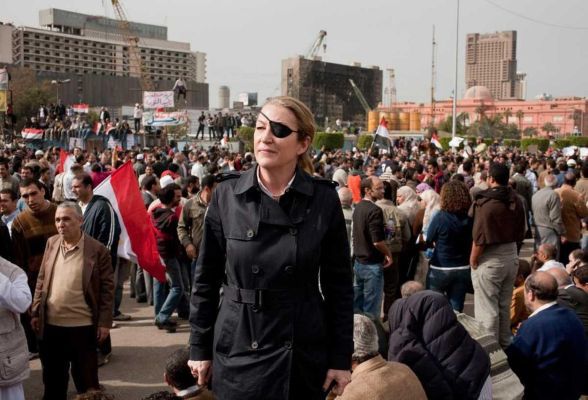 |
U.S. war correspondent Marie Colvin in Cairo, Egypt. (AFP-Yonhap News) |
Why was Marie Colvin, who became one of Britain’s most celebrated war correspondents, in Homs, Syria, in February 2012? One thing’s for sure: She had not been invited. After the Syrian government closed its borders to journalists, intrepid reporters like Colvin and her colleague from Britain’s Sunday Times, photographer Paul Conroy, were forced to take extreme measures to cover the nation’s civil war.
Colvin and Conroy’s epic journey from Beirut, involved minivans, pickup trucks, motorbikes, heart-pounding sprints across fields while being strafed by machine-gun fire, and a two-mile crawl through an improvised tunnel that was little more than a muddy hole in the ground.
Once in Syria, their drivers dodged bullets and rocket-propelled grenades to reach the Sunni neighborhood of Baba Amr, which had been under constant siege by the Syrian army for more than two weeks when the exhausted journalists arrived. Taking in the scene, former soldier Conroy, who had chronicled conflicts in Iraq, Congo, Kosovo, and Libya, declared, “This wasn’t war. It was slaughter.”
It was a ferocious determination to tell the world about the brutal conditions civilians endure in places like Baba Amr that drove Marie Colvin into dangerous locations. Soon after they got their first look at the situation in Syria, Colvin told Conroy, “We need to shout and scream to the world about this one.” Seven days later, on Feb. 22, Colvin, 56, was killed in what Conroy claims was an intentional government attack on the building where they were based.
Fortunately, Conroy’s new book, “Under the Wire: Marie Colvin’s Final Assignment” (Weinstein Books), means that her bravery and commitment will not be forgotten.
Readers who come to this book knowing little about Colvin will leave in much the same condition. They will learn that she was a creative curser, that she always wore fancy silk underwear underneath her body armor, that she had no sense of direction, and that she was passionate about sailing.
But they will not find an explanation for how a Long Islander came to live and work in Britain, how she broke into journalism, or even, beyond a handful of sentences, how she came to wear her signature eye patch. (She lost the sight in her left eye in April 2001, when she was struck by shrapnel while covering Sri Lanka’s civil war.) Some American readers might also wish that the publisher had translated some of Conroy’s colorful British-isms ― his talk of Nando’s, MOT tests, and his embarrassment at finding himself “hugging a ginger” make little sense here.
Despite the book’s flaws, Conroy deserves praise for his gripping portrayal of the appalling conditions contemporary war correspondents face. Judging from “Under the Wire,” they have little in common with the business-suited journalists we see at presidential press conferences. Instead, they are more like the competitors on television’s “Survivor” ― half-starved, sleep-deprived and forced to overcome extreme physical challenges. And unlike contestants on the TV game show, reporters sometimes come under live fire in hostile territory.
Seriously injured in the attack that killed Colvin, Conroy was forced to leave Syria by the same perilous route they had used to get in. When he reached relative safety, he was told that the other members of his escape party had been shot or captured. That turned out not to be true, but it proves how easily facts can be mangled when “news” comes from sources who haven’t witnessed events for themselves.
Marie Colvin’s prose is the most glaring absence in “Under the Wire,” which includes just a couple of brief emails she dashed off to editors in London. Those curious to read the articles that Colvin took such risks to compose will find a wonderful selection in “On the Front Line: The Collected Journalism of Marie Colvin” (Harper Press, $19.99).
From 1987 reports on the Iran-Iraq War to her final dispatch from Syria, with stops in Kosovo, Chechnya and all the major conflict zones in between, the language is clear and passionate, the focus deeply humane.
Also included is her acceptance speech for Britain’s 2001 Woman of the Year award, in which she declared: “The point is to try to report as truthfully as you know how about what you see and make that part of the record. You can’t get that information in a war without going to a place where people are being shot and they are shooting at you. The real difficulty is having enough faith in humanity to believe that someone will care.”
By June Thomas
(Newsday)
(MCT Information Services)





![[Herald Interview] 'Trump will use tariffs as first line of defense for American manufacturing'](http://res.heraldm.com/phpwas/restmb_idxmake.php?idx=644&simg=/content/image/2024/11/26/20241126050017_0.jpg)


![[Herald Review] 'Gangnam B-Side' combines social realism with masterful suspense, performance](http://res.heraldm.com/phpwas/restmb_idxmake.php?idx=644&simg=/content/image/2024/11/25/20241125050072_0.jpg)